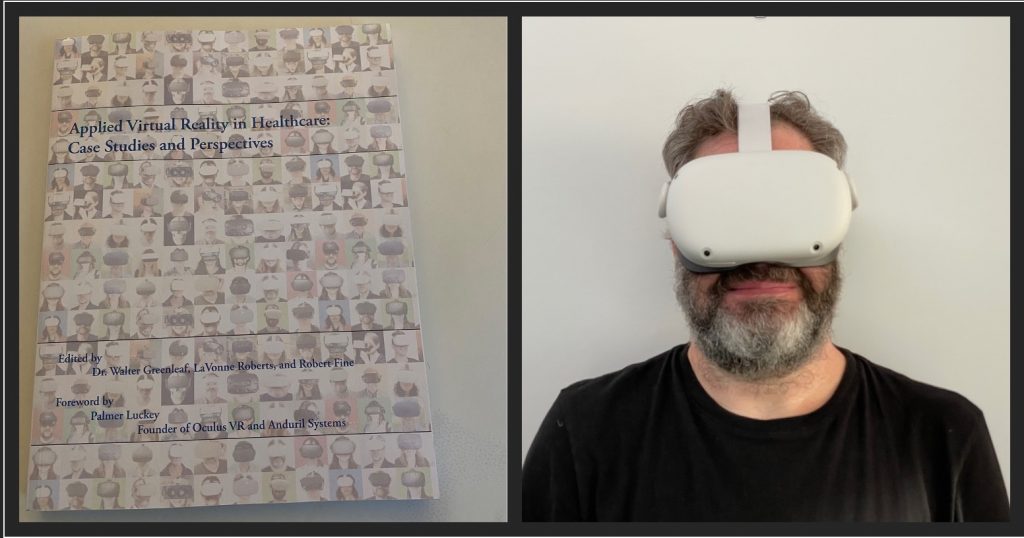
To the right, that’s Bob Fine, one of the 3 editors. Spoiler: all of the authors are pictured in their headsets.
This article presents the recent book, Applied Virtual Reality in Healthcare: Case Studies and Perspectives.
“Applied Virtual Reality in Healthcare is like attending a several-day, virtual reality healthcare conference on demand and at your own speed. It’s a practical book written in a pedagogic style that can benefit both the beginner looking for an overview or those already working on a particular healthcare application and who want to hear from experts working on other facets. You’ll want to read Applied Virtual Reality in Healthcare in its entirety and keep it handy for further consultation” Denise Silber, co-founder of VRforHealth and a happy reader of her copy!
Edited by Dr Walter Greenleaf, LaVonne Roberts, and Robert Fine, with a foreword by Palmer Luckey, founder of Oculus VR (a genius choice for a foreword author) and contributions from 40 authors, Applied Virtual Reality in Healthcare contains 340 pages of useful information about the multiple uses of virtual reality in health — for professional training, to prepare more efficient surgeries, to reduce pain and anxiety, to bring relief in various mental health conditions. Each of the 36 chapters or topics is the equivalent of a standalone, educational lecture with descriptions charts and photos, bibliographic references. The index contains author contact information and a glossary of nearly 150 terms. The content focuses on practical experience, since each chapter is written by one person or a team that works on the topic that is presented. Thanks to the clear, concise writing style and judicious use of visuals, reading a topic is almost like attending a conference session “on demand” . And instead of dashing up front to try to grab the speaker before she walks out, you can contact them through the preferred coordinates that they have provided.
The table of contents is divided into the following sections: Perspectives, Surgery, Training, Pediatrics, Elderly Care, Health and Wellness, Hospital Management, Evaluation, New Frontiers.
-In surgery, we learn about VR applications to neurosurgery, craniomaxillofacial surgery, and 3D modeling for surgical planning.
-Training covers VR simulation for clinical training, orthopedic surgical skill training, kidney care education, understanding the challenges of aging, and caregiver training.
-Pediatrics includes using VR for the patient experience and for reducing fear of needles in children and teens.
-In Mental Health, you will learn about social virtual reality, the virtual sandtray, VR use after trauma, in PTSD, and for autism.
-The elder care chapter covers post-pandemic learnings of the application of virtual reality.
-In Health and Wellness, we find a chapter about VR and crisis, one about how to design restorative Virtual Reality environments, and one about using VR and augmented reality to improve one’s state of mind.
-Hospital Management describes deployment of VR in the hospital setting.
-The section on pain and neurological rehabilitation explains VR’s applications to chronic pain, for functional and mobility improvements, and using a VR game-based approach to personalized motor therapy.
-In “evaluation, “we read about the importance of testing and validating VR efficacy and acceptability and as well the technical considerations, the limitations and opportunities and the issues around data.
And finally, in new frontiers, we learn about the critical role of scent in VR healthcare outcomes, the therapeutic effects of ketamine VR therapy, veterinary applications, and the use of VR for the measurement of the emotional state.
The book website is here. Congratulations to the editors and authors on this fine publication!
This article was originally published on vrforhealth
